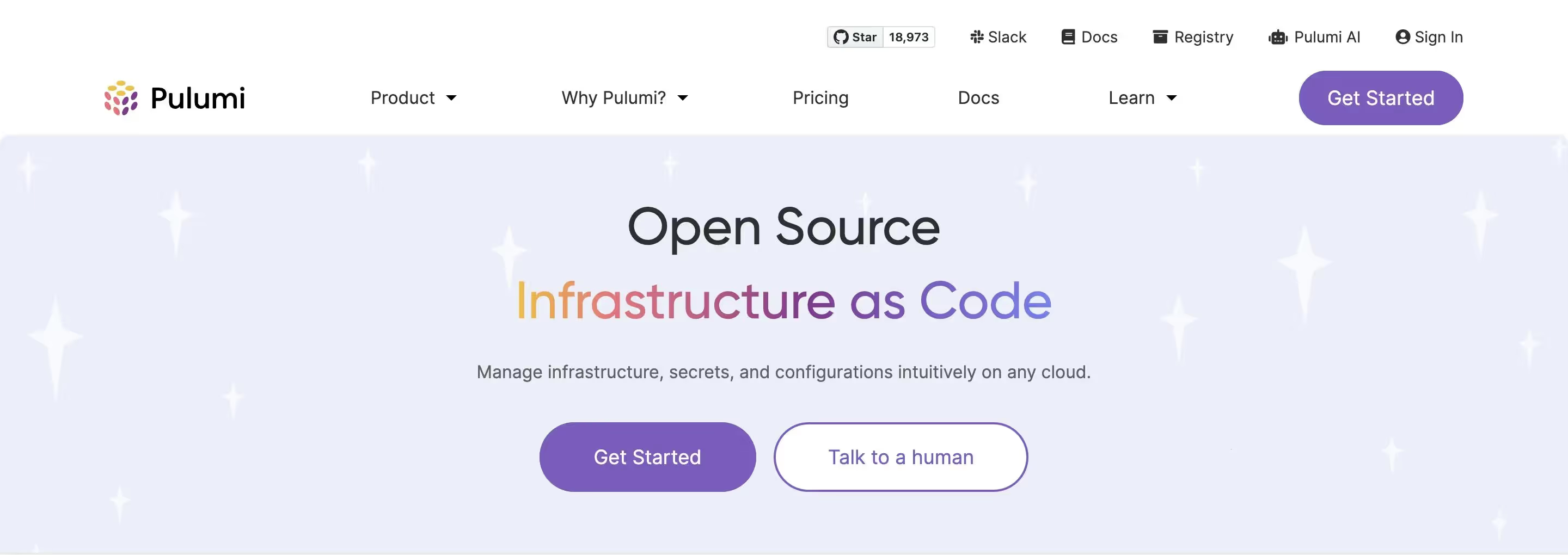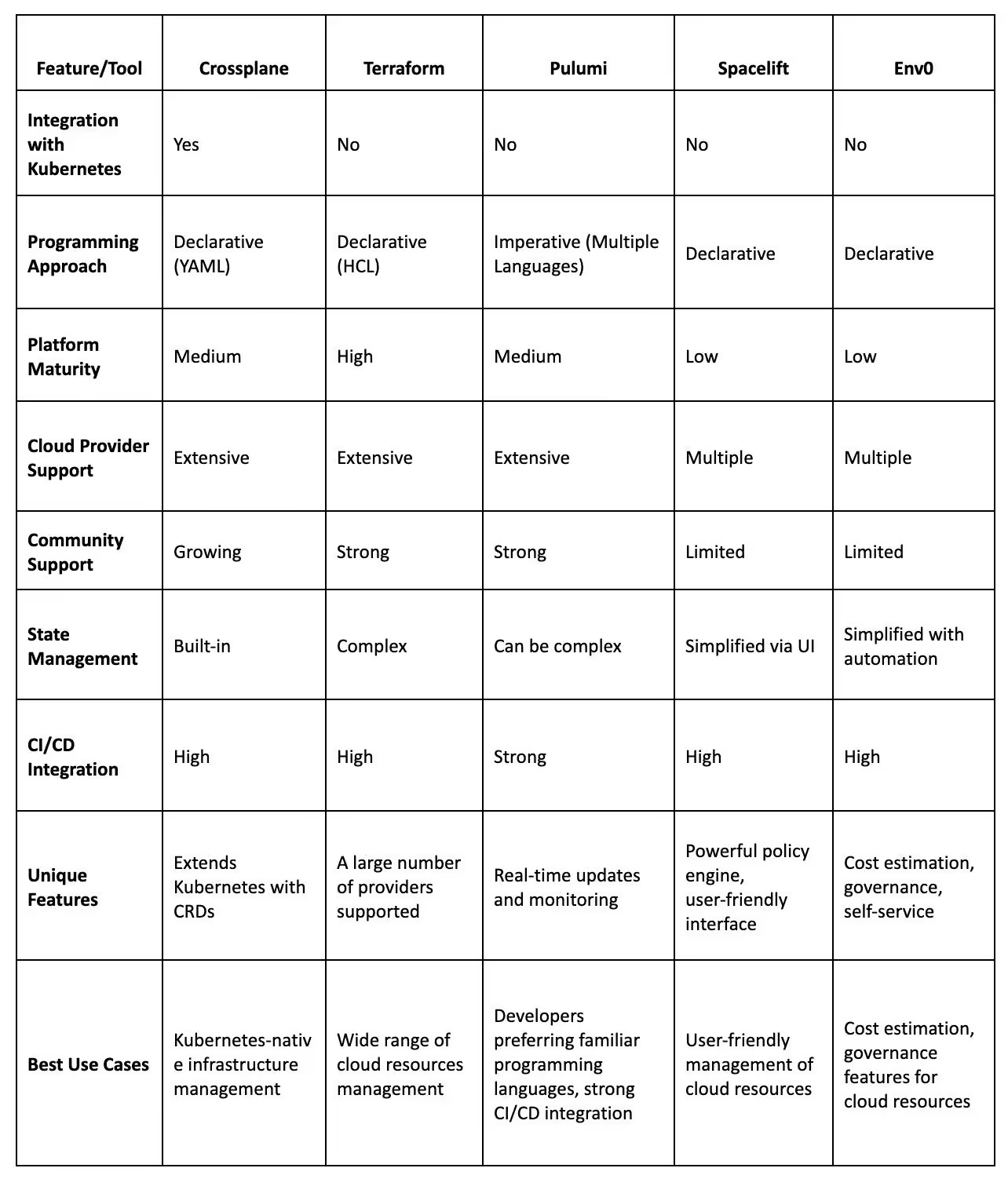


Top 5 Crossplane Alternatives & Competitors



Key Points:
- While Crossplane focuses on Kubernetes-native control, tools like Terraform (maturity/scale), Pulumi (programming language flexibility), Spacelift (policy engine/UI), and Env0 (cost governance/self-service) offer different approaches that may better suit specific technical or organizational needs.
- The evolution of IaC is moving away from low-level configuration to high-level automation. The best choice is the one that minimizes YAML, speeds up deployment, and provides a unified workflow for both applications and underlying infrastructure.
- Qovery provides an intuitive, self-service platform that automates the entire application and infrastructure deployment pipeline, uniquely designed to work with Crossplane to deliver a robust, developer-centric experience (DevEx).
The race to manage multi-cloud infrastructure has crowned Crossplane a pioneer, using the declarative power of Kubernetes to treat infrastructure like code. But the cloud moves fast. While Crossplane remains a powerhouse, the modern landscape demands alternatives that offer specialized features, superior developer experience, or complete DevOps automation.
This article cuts through the noise to explore the leading Crossplane alternatives. We’ll show how these competing tools can better align with your specific project needs—and why one stands out as a powerful complement to Crossplane itself.
What is Crossplane?
Crossplane is an open-source Infrastructure as Code (IaC) tool that extends Kubernetes to manage and compose infrastructure across multiple vendors. It’s a powerful tool that brings efficient deployment techniques to the forefront through which developers manage their infrastructure just like they manage their applications.
Crossplane introduces a new layer of abstraction over traditional IaC tools. It leverages the Kubernetes control plane to manage a wide range of public and private cloud services. This means you can use the same declarative API you use to run your applications to provision and manage your cloud infrastructure.
Crossplane achieves this by introducing Managed Resources that represent granular, composable pieces of infrastructure in a cloud provider, and Composite Resources that group these managed resources into higher-level abstractions.
Key Features and Benefits of Using Crossplane
Using Crossplane comes with several key features and benefits:
- Multi-cloud deployments: Crossplane supports a wide range of cloud providers, allowing you to deploy your applications across different vendors and avoid vendor lock-in. This feature is complemented by Qovery’s ability to manage applications across multiple environments.
- Infrastructure as Code: With Crossplane, you can manage your infrastructure using the same declarative syntax as Kubernetes. This makes it easier to version control and collaborate on your infrastructure. Qovery enhances this feature by providing a user-friendly interface for managing your applications and infrastructure.
- Workload Portability: Crossplane enables workload portability, which means you can move your applications and configurations between different cloud providers without changing your code. Qovery complements this by providing a consistent environment for your applications, regardless of the underlying cloud provider.
- Real-time updates and monitoring: Crossplane provides detailed insights into your resources, allowing you to monitor and manage them in real time. Qovery enhances this feature by providing additional insights into your application performance and resource usage.
- Integration with existing tools: Crossplane works seamlessly with existing tools like Helm, OAM, and more, providing a comprehensive solution for cloud-native development. Qovery complements this by integrating with your existing CI/CD pipelines and providing additional tools for application management.
Top 5 Crossplane Alternatives & Competitors
The right tool depends on your use case. Here are the top alternatives, including the leading choice for a streamlined developer experience.
1. Qovery
Qovery is a DevOps Automation tool designed to provide a unified workflow for application deployment and infrastructure management. While not a direct IaC competitor like others, it functions as a high-level alternative by abstracting away the complexity of managing Kubernetes and underlying cloud resources. Crucially, it provides the "glue" layer that simplifies the developer experience for tools like Crossplane.
Pros:
- Best-in-Class DevEx: Intuitive UI/CLI for instant application and environment deployment.
- Full Automation: Handles Kubernetes setup, environment cloning, and CI/CD pipelines automatically.
- Complements Crossplane: Works seamlessly with Crossplane to add a high-level, self-service layer for developers.
Cons:
- Requires a managed Kubernetes cluster (EKS, AKS, GKE).
- Focuses more on application delivery than pure infrastructure composition.
Use Qovery for:
- Teams prioritizing developer productivity and self-service deployment.
- Organizations looking for the fastest path from code to cloud, with full automation.
- Environments where Qovery and Crossplane are used together to combine deep infrastructure control with simple application management.
Ready to stop managing complexity and start shipping faster?
Take control of your cloud workflow.
- 🚀 Start your free Qovery trial and experience simplified DevOps automation.
- 📅 Book a personalized demo to see how Qovery integrates with and supercharges tools like Crossplane for your team.
2. Terraform
Terraform is an open-source tool that allows you to define and provide data center infrastructure using a declarative configuration language. It is different from Crossplane in that it is not tied to Kubernetes and does not use custom resource definitions (CRDs).

Pros:
- Mature and widely adopted.
- Supports a large number of cloud providers.
- Strong community support.
Cons:
- Learning curve can be steep.
- State management can be complex.
3. Use Terraform for:
- Ideal for teams that need to manage a wide range of cloud resources.
- Suitable for those who prefer a declarative approach to infrastructure as code.
- Great for organizations looking for a mature and widely adopted tool.
- Works well for teams that need to support a large number of cloud providers.
Pulumi
Pulumi is another Infrastructure as Code (IaC) tool that allows developers to use familiar programming languages to define and manage cloud resources. Unlike Crossplane, Pulumi does not extend Kubernetes but provides its own platform for infrastructure management.

Pros:
- Supports multiple programming languages.
- Real-time updates and monitoring.
- Strong integration with existing CI/CD pipelines.
Cons:
- Less mature than some alternatives.
- Some complexities with state management.
User Pulumi for:
- A good choice for developers who prefer to use a familiar programming language for infrastructure management.
- Suitable for teams that need strong integration with existing CI/CD pipelines.
- Ideal for organizations that require real-time updates and monitoring of their infrastructure.
- Works well for teams that are comfortable with a tool that is less mature than some alternatives.

4. Spacelift
Spacelift is a cloud-native continuous delivery platform that helps you manage your infrastructure as code. Unlike Crossplane, Spacelift is not tied to Kubernetes and provides its own platform for infrastructure management.

Pros:
- Provides a powerful policy engine.
- Supports multiple cloud providers.
- Offers a user-friendly interface.
Cons:
- Less mature than some alternatives.
- Limited community support.
Use Spacelift for:
- Best for teams that need a user-friendly interface for managing a wide range of cloud resources.
- Suitable for organizations that require a powerful policy engine for managing their infrastructure.
- Ideal for teams that need to support multiple cloud providers.
- Works well for organizations that are comfortable with a tool that is less mature than some alternatives.
5. Env0
Env0 is a cloud management platform that provides automated and collaborative remote-run workflows for Infrastructure as Code. Unlike Crossplane, Env0 is not tied to Kubernetes and provides its own platform for infrastructure management.

Pros:
- Supports multiple Infrastructures as Code frameworks.
- Provides cost estimation and governance features.
- Offers self-service capabilities for developers.
Cons:
- Limited support for non-cloud resources.
- Less mature than some alternatives.
Use Env0 for:
- A good choice for organizations that need cost estimation and governance features for their cloud resources.
- Suitable for teams that require support for multiple Infrastructures as Code frameworks.
- Ideal for organizations that need to provide self-service capabilities for developers.
- Works well for teams that are comfortable with a tool that has limited support for non-cloud resources.
Comparison Table
Below is a summary table for a comparison of Crossplane alternatives.

How Qovery Complements Crossplane
Qovery and Crossplane can work together to provide a robust, scalable, and efficient cloud infrastructure management solution. Here’s how:
Qovery, a DevOps Automation tool, can leverage Crossplane’s multi-cloud deployment capabilities to provide seamless deployment across various cloud providers. This combination allows developers to focus on writing code, while Qovery and Crossplane handle the complexities of infrastructure management. To explore further how Qovery complements Crossplane, check out this article that explores this combination in detail.
Benefits of Using Qovery and Crossplane Together
Using Qovery and Crossplane together brings several benefits:
- Enhanced Developer Experience (DevEx): With Qovery’s intuitive interface and Crossplane’s infrastructure as code capabilities, developers can manage cloud resources with ease, leading to improved productivity.
- Self-Service Capabilities: Qovery provides self-service capabilities, allowing developers to deploy and manage applications independently.
- Unified Workflow: By integrating Qovery and Crossplane, teams can establish a unified workflow for application deployment and infrastructure management. This can lead to more efficient processes and less context-switching for developers.
- Real-Time Updates and Monitoring: Both Qovery and Crossplane provide real-time updates and monitoring capabilities, ensuring developers have up-to-date information about their applications and resources.
Conclusion
The right IaC strategy is one that empowers your team without sacrificing control.
- If deep, mature multi-cloud resource definition is your priority, Terraform is the gold standard.
- If you value using familiar programming languages for your infrastructure, Pulumi is your best bet.
- If governance, policy enforcement, and a clean UI are critical, look at Spacelift and Env0.
But if you want to eliminate DevOps overhead, unify your workflow, and give your developers the fastest path to production—while still maintaining advanced infrastructure control—the answer is to start with Qovery.
Ready to stop managing complexity and start shipping faster?
Take control of your cloud workflow.
- 🚀 Start your free Qovery trial and experience simplified DevOps automation.
- 📅 Book a personalized demo to see how Qovery integrates with and supercharges tools like Crossplane for your team.

Suggested articles
.webp)



.svg)
.svg)
.svg)












